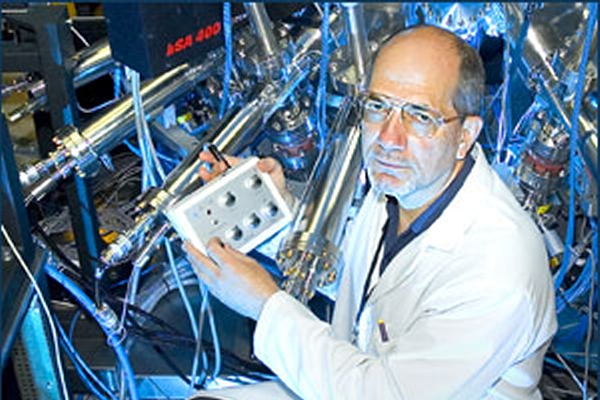Superconducting film key to next-gen electronics
Scientists in the US have created a ultra thin superconducting film that could be used by the electronics sector to improve power efficiency.

Research scientists in the US have developed a new form of superconductor using layers of ultra thin film.
By using film, the superconductors are easier to manufacture and handle.
The research work, the scientists believe, could help underpin the development of the next generation of power-efficient electrical devices.
"What we have done is we have put together two materials, neither of which is a superconductor, and we found their interface - where they touch - is superconducting," said physicist Ivan Bozovic of the US Department of Energy's Brookhaven National Laboratory.
"This superconducting layer is extremely thin. It is thinner than one nanometer, which is one billionth of a metre," added Bozovic.
"It opens vistas for further progress, including using these techniques to significantly enhance superconducting properties in other known or new superconductors."
Like their name implies, superconductors are useful because they are extremely efficient at conducting electricity.
Sign up today and you will receive a free copy of our Future Focus 2025 report - the leading guidance on AI, cybersecurity and other IT challenges as per 700+ senior executives
If cooled to the material's critical operating temperature, they have no resistance to the flow of electrical current, unlike ordinary electrical wires, which can eventually overheat.
The superconductors used in a magnetic resonance imaging or MRI machine, for example, must be cooled with liquid helium to keep them at four on the Kelvin scale, or near absolute zero minus 452.47 degrees Fahrenheit (minus 269.15 degrees Celsius).
The superconducting film developed by scientists at Brookhaven, however, work at temperatures of 50 Kelvin or minus 369.67 degrees Fahrenheit (minus 223.15 degrees Celsius).
"The practicality of superconductivity depends in some sense on the refrigeration you use to cool it down," Bozovic said.
At 50 Kelvin, the superconducting film is close to the point where it could be cooled inexpensively by liquid nitrogen, which cools to 77 Kelvin or minus 321.07 degrees Fahrenheit (minus 196.15 degrees Celsius).
"It brings us one step closer to producing mass-scale superconducting electronics," he said.
He said the ultimate goal is to develop superconducting materials that could be used at room temperature.
ITPro is a global business technology website providing the latest news, analysis, and business insight for IT decision-makers. Whether it's cyber security, cloud computing, IT infrastructure, or business strategy, we aim to equip leaders with the data they need to make informed IT investments.
For regular updates delivered to your inbox and social feeds, be sure to sign up to our daily newsletter and follow on us LinkedIn and Twitter.
-
 Gender diversity improvements could be the key to tackling the UK's AI skills shortage
Gender diversity improvements could be the key to tackling the UK's AI skills shortageNews Encouraging more women to pursue tech careers could plug huge gaps in the AI workforce
-
 Researchers claim Salt Typhoon masterminds learned their trade at Cisco Network Academy
Researchers claim Salt Typhoon masterminds learned their trade at Cisco Network AcademyNews The Salt Typhoon hacker group has targeted telecoms operators and US National Guard networks in recent years
-
 Beyond the upgrade: How to maximize IT investments and minimize waste
Beyond the upgrade: How to maximize IT investments and minimize wasteHow to maintain optimal performance and productivity with your fleet of hardware and stave off the next upgrade cycle for a bit longer
-
 Energy efficiency and sustainability demands are transforming IT strategy
Energy efficiency and sustainability demands are transforming IT strategywhitepaper How Dell Technologies innovations are leading the way in energy effiency and sustainability
-
 Energy efficiency and sustainability demands are transforming IT strategy
Energy efficiency and sustainability demands are transforming IT strategywhitepaper How Dell Technologies innovations are leading the way in energy effiency and sustainability
-
 Your guide to smarter printing: 2024 edition
Your guide to smarter printing: 2024 editionWhitepaper Making smarter printing simple for all businesses
-
 How to empower employees to accelerate emissions reduction
How to empower employees to accelerate emissions reductionin depth With ICT accounting for as much as 3% of global carbon emissions, the same as aviation, the industry needs to increase emissions reduction
-
 How much say does IT really have in sustainability initiatives?
How much say does IT really have in sustainability initiatives?ITPro Network Vendors are ready to proclaim their green credentials, but as members of the ITPro Network explain, making changes on the ground can be complex
-
 ESG: Designing the ideal digital work experience for the next generation of innovators
ESG: Designing the ideal digital work experience for the next generation of innovatorsWhitepaper What users want, why it's critical to give it to them, and how the whole organization can benefit
-
 A guide to ESG reporting frameworks
A guide to ESG reporting frameworksWhitepaper Guidelines to assist with your approach to ESG reporting

